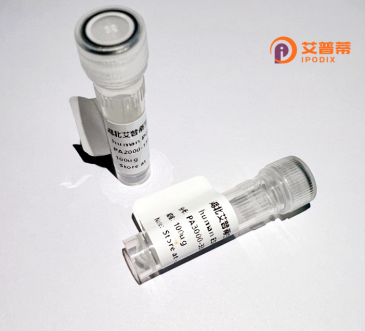
| 纯度 | >90%SDS-PAGE. |
| 种属 | Human |
| 靶点 | CBLL1 |
| Uniprot No | Q75N03 |
| 内毒素 | < 0.01EU/μg |
| 表达宿主 | E.coli |
| 表达区间 | 1-491aa |
| 氨基酸序列 | MDHTDNELQGTNSSGSLGGLDVRRRIPIKLISKQANKAKPAPRTQRTINRMPAKAPPGDEEGFDYNEEERYDCKGGELFANQRRFPGHLFWDFQINILGEKDDTPVHFCDKCGLPIKIYGRMIPCKHVFCYDCAILHEKKGDKMCPGCSDPVQRIEQCTRGSLFMCSIVQGCKRTYLSQRDLQAHINHRHMRAGKPVTRASLENVHPPIAPPPTEIPERFIMPPDKHHMSHIPPKQHIMMPPPPLQHVPHEHYNQPHEDIRAPPAELSMAPPPPRSVSQETFRISTRKHSNLITVPIQDDSNSGAREPPPPAPAPAHHHPEYQGQPVVSHPHHIMPPQQHYAPPPPPPPPISHPMPHPPQAAGTPHLVYSQAPPPPMTSAPPPITPPPGHIIAQMPPYMNHPPPGPPPPQHGGPPVTAPPPHHYNPNSLPQFTEDQGTPSPPFTQPGGMSPGIWPAPRGPPPPPRLQGPPSQTPLPGPHHPDQTRYRPYYQ |
| 分子量 | 80.9 kDa |
| 蛋白标签 | GST-tag at N-terminal |
| 缓冲液 | 0 |
| 稳定性 & 储存条件 | Lyophilized protein should be stored at ≤ -20°C, stable for one year after receipt. Reconstituted protein solution can be stored at 2-8°C for 2-7 days. Aliquots of reconstituted samples are stable at ≤ -20°C for 3 months. |
| 复溶 | Always centrifuge tubes before opening.Do not mix by vortex or pipetting. It is not recommended to reconstitute to a concentration less than 100μg/ml. Dissolve the lyophilized protein in distilled water. Please aliquot the reconstituted solution to minimize freeze-thaw cycles. |
以下是与重组人E3泛素蛋白连接酶Hakai(CBLL1)相关的3篇代表性文献,简要概括其内容:
1. **文献名称**:Hakai, a c-Cbl-like protein, ubiquitinates and induces endocytosis of the E-cadherin complex
**作者**:Fujita Y et al.
**摘要**:首次发现Hakai作为E3泛素连接酶,通过泛素化E-cadherin促进其内吞和降解,导致上皮-间质转化(EMT),揭示了其在细胞黏附和肿瘤转移中的作用(发表于*Nature Cell Biology*, 2002)。
2. **文献名称**:Structural and functional characterization of the Smurf1/Hakai NEDD8 ligase complex
**作者**:Alonso‑Iglesias H et al.
**摘要**:研究Hakai的结构功能,揭示其Smurf同源结构域介导底物识别,并阐明其在E3泛素连接酶复合体中的调控机制(发表于*Journal of Biological Chemistry*, 2019)。
3. **文献名称**:Hakai ubiquitinates histone H2B to promote Snail1 stabilization and tumor metastasis
**作者**:Wan L et al.
**摘要**:发现Hakai通过泛素化组蛋白H2B,抑制蛋白酶体降解转录因子Snail1.增强乳腺癌细胞的侵袭转移能力(发表于*Oncogene*, 2017)。
**补充参考**:
4. **文献名称**:Phosphorylation of Hakai mediates its proteasomal degradation and regulates cell migration
**作者**:Sánchez‑Olea R et al.
**摘要**:揭示Hakai自身被泛素-蛋白酶体系统降解的调控机制,指出其磷酸化状态通过Akt信号通路影响肿瘤细胞迁移(发表于*Cellular Signalling*, 2015)。
这些研究覆盖Hakai在EMT、底物识别、肿瘤转移及自身调控方面的关键机制。
CBL-like protein 1 (CBLL1), commonly known as Hakai, is a RING finger-type E3 ubiquitin-protein ligase first identified in 2002 through its interaction with the tyrosine-phosphorylated cytoplasmic domain of E-cadherin. The name "Hakai" (Japanese for "destruction") reflects its role in promoting proteasomal degradation of target proteins via polyubiquitination. Structurally, Hakai contains a conserved C-terminal RING domain essential for its ubiquitin ligase activity and an N-terminal SH2 domain that binds phosphotyrosine residues on substrates.
Functionally, Hakai is best characterized for its involvement in epithelial-mesenchymal transition (EMT), a critical process in embryogenesis and cancer metastasis. By ubiquitinating E-cadherin upon phosphorylation by Src kinase, Hakai triggers E-cadherin endocytosis and degradation, disrupting cell-cell adhesion and enhancing cell motility. Beyond EMT, Hakai regulates diverse pathways, including receptor tyrosine kinase signaling (e.g., EGFR, Met) and mRNA metabolism. Studies link it to tumor progression, stem cell maintenance, and neurological processes, though its substrates and mechanisms remain partially explored.
Recent research highlights context-dependent roles—Hakai can act as both oncogene and tumor suppressor depending on cellular conditions. Its expression is elevated in multiple cancers (e.g., breast, colon), correlating with poor prognosis. Emerging evidence also implicates Hakai in neurodevelopment and synaptic plasticity. While its physiological regulation involves tyrosine kinase activation and subcellular localization, comprehensive molecular networks remain an active research focus, particularly in disease therapeutics.
×